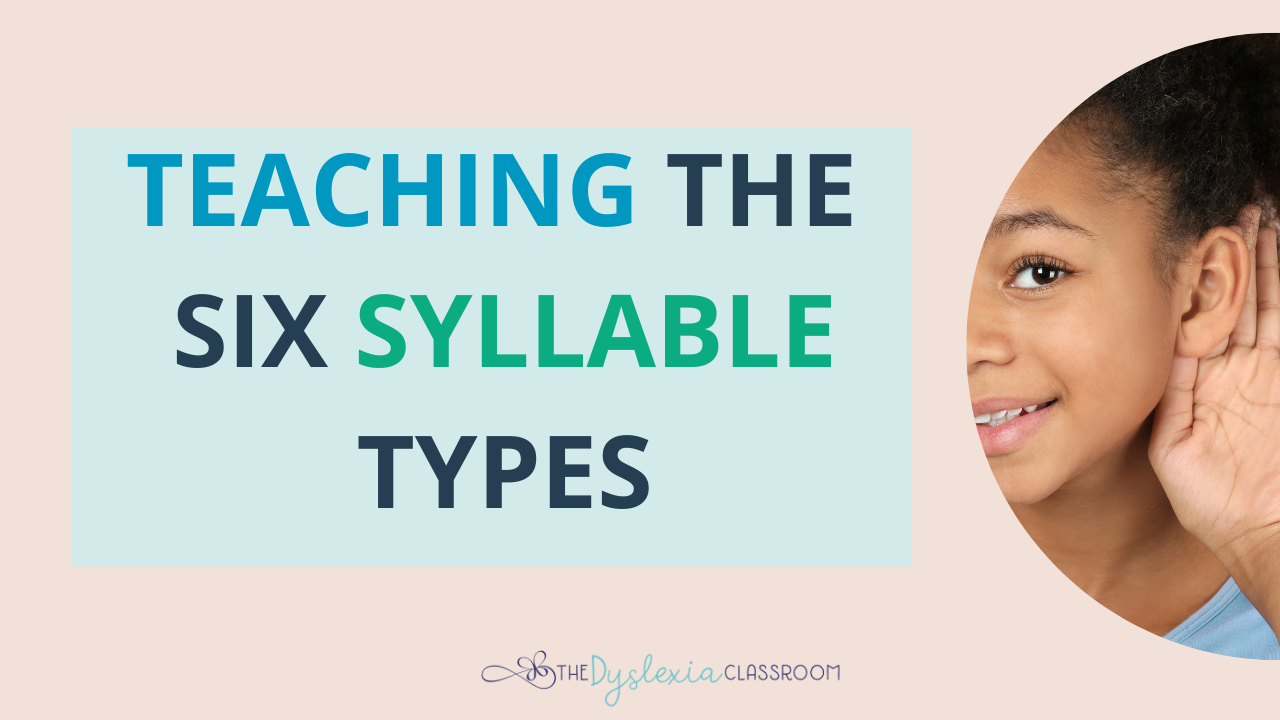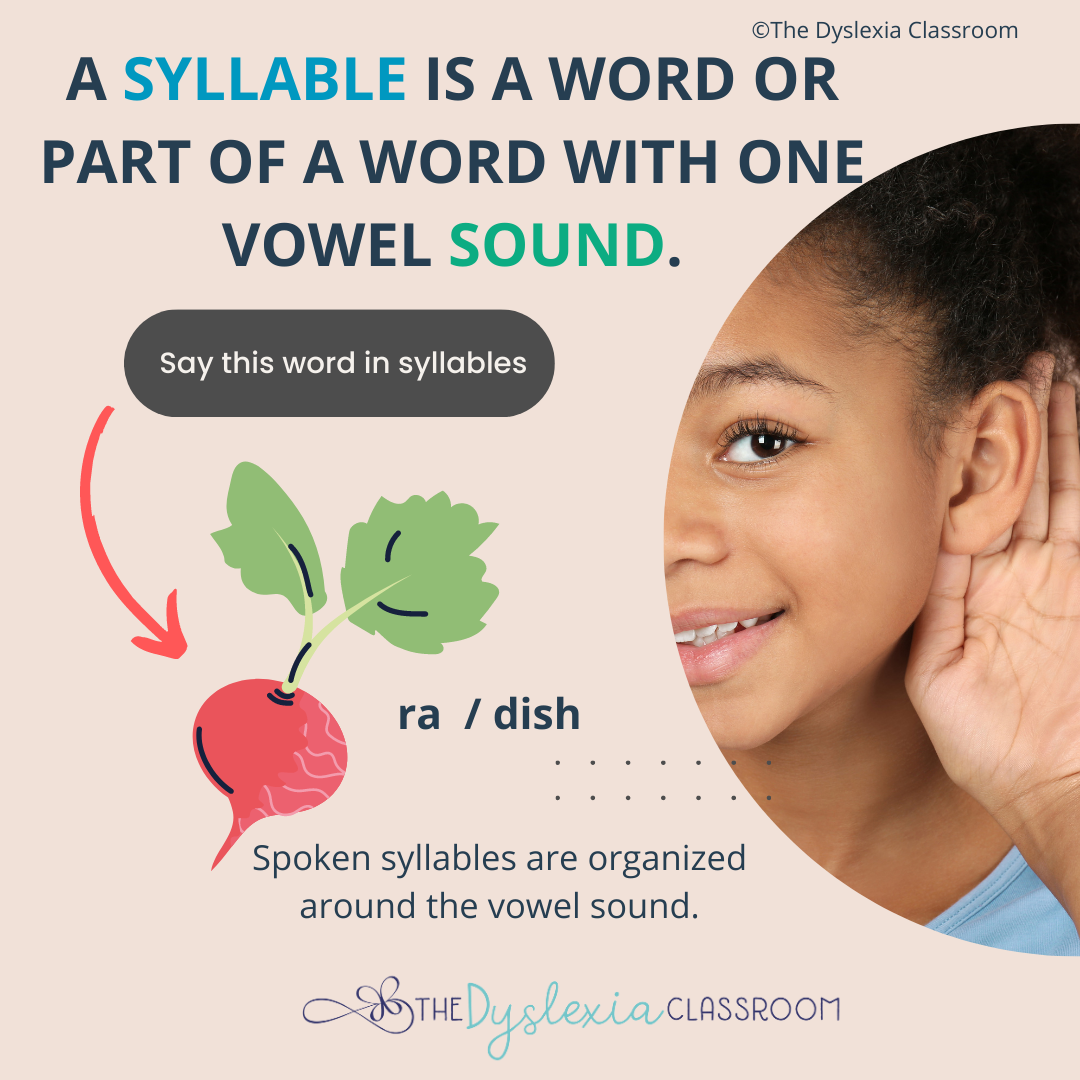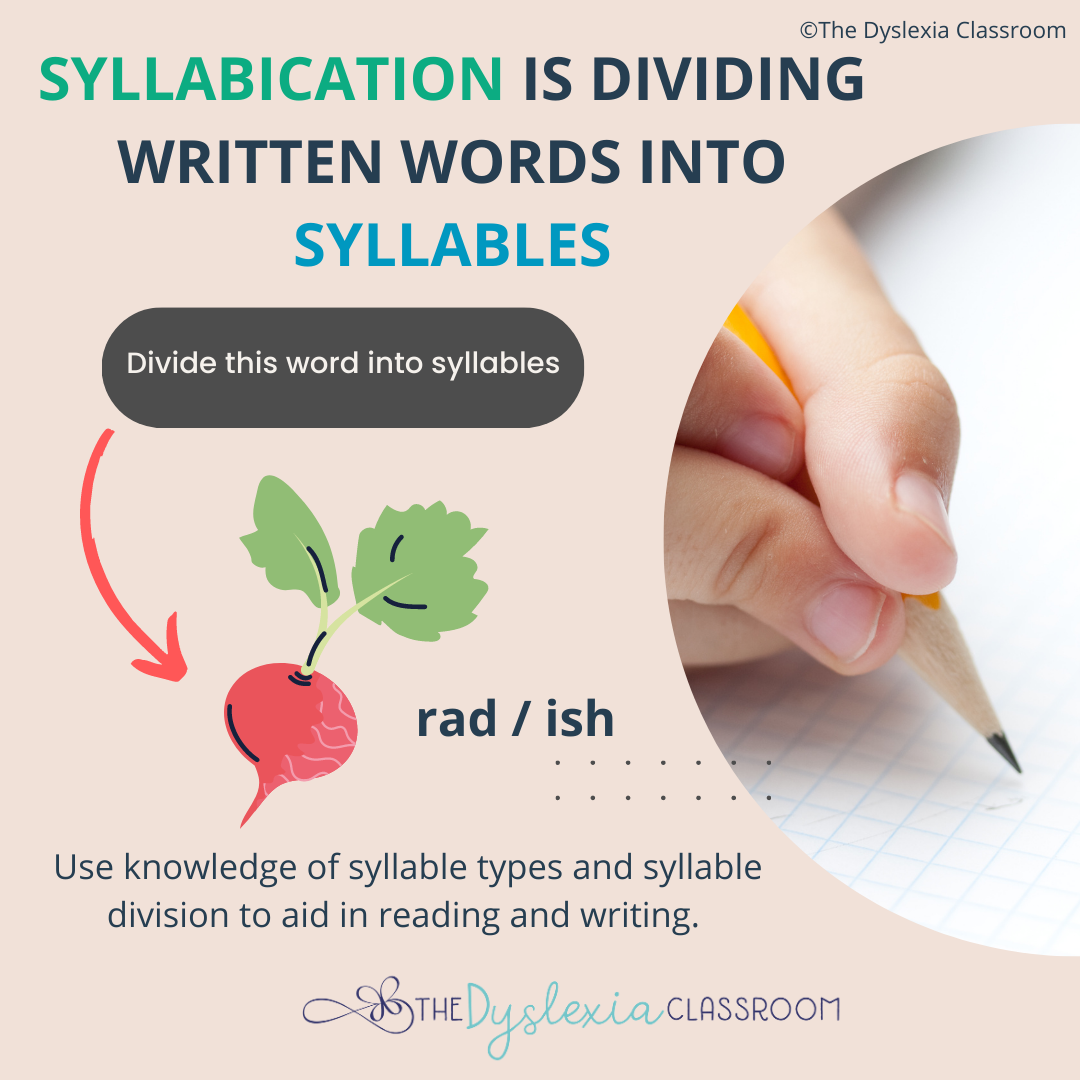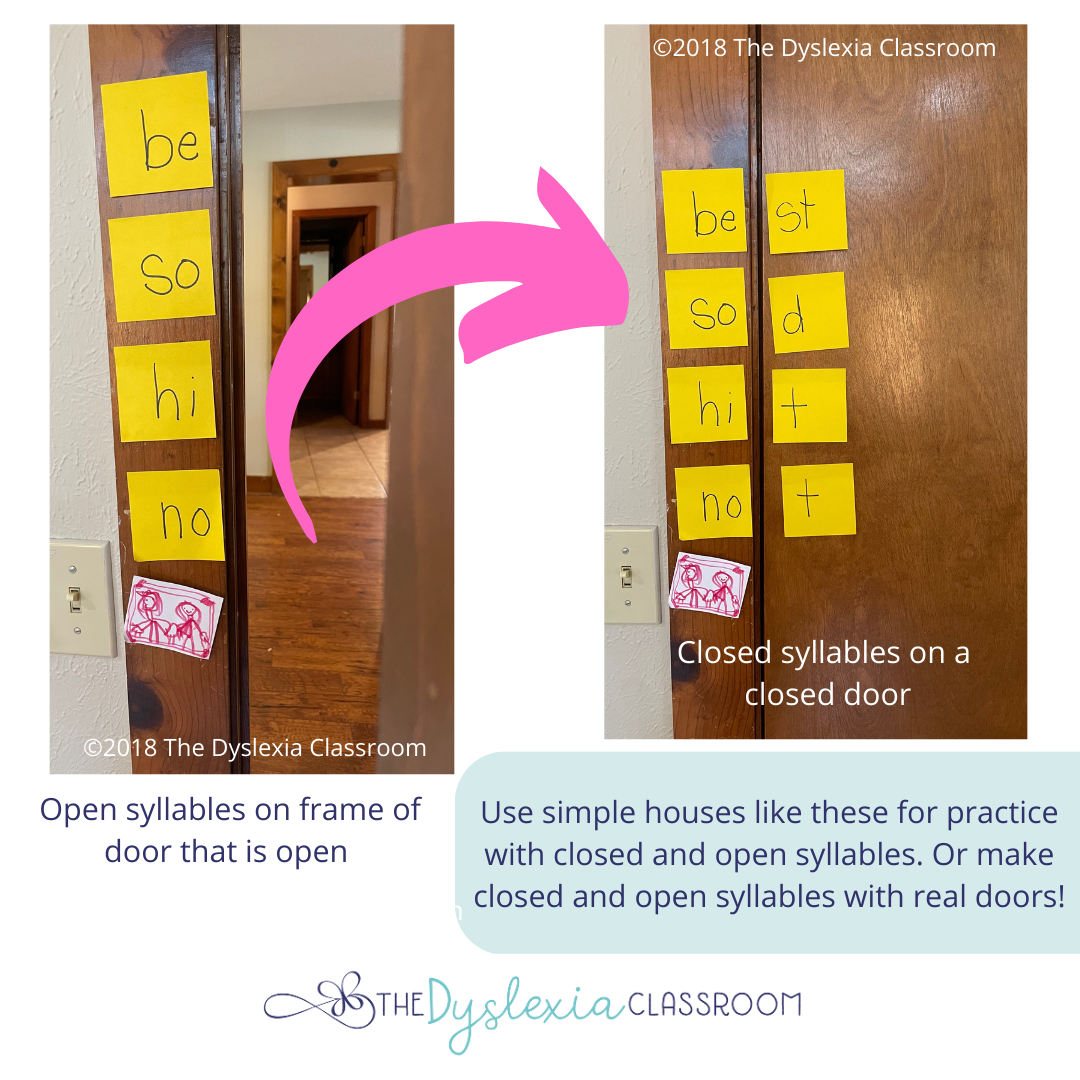Teaching the Six Syllable Types

*This is part 2 of the series about syllables and syllable types in reading instruction. Read part 1 here.
In part 1 of the What are syllable types and why do they matter? blog series, I shared some information on why we should teach syllables, plus some tips for teaching students, and provided some scaffolds. This part of the series continues with syllable knowledge and connects to syllable types.
Why Teach the Six Syllables?
As teachers, we cannot assume that children automatically know the sounds linked to letters. Therefore, we must explicitly teach sound-symbol correspondences, which provide a foundation for students to read one-syllable words successfully. But what must we teach to allow students to move beyond this? Teaching the Six Syllable Types provides a robust foundation for students and provides students with word attack strategies and tools to approach unknown words.
In addition to sound-symbol relationships, explicitly teaching syllable types, syllable division (think word attack strategies), and morphology to provide tools and strategies sets students up to read multisyllabic words successfully. At the foundational base of this is the knowledge of sounds and syllables known as syllable knowledge, which was discussed in part 1,
A syllable is a word or part of a word with one vowel sound.
I teach my students that a syllable is a word or part of a word with one vowel sound. I emphasize this over a written vowel letter because some syllables in the English language do not have a written vowel but have a vowel sound. Read more about this in part 1.
Spoken Syllables vs. Written Syllables
When teaching about syllables, we need to have an awareness that spoken syllables and written syllables may differ. Spoken syllables refer to a unit of spoken language that includes one vowel sound. We help students recognize this by teaching the articulatory feature with a mirror, as the syllable is visible to us because the mouth opens. The voice is engaged on the vowel marker because it is the syllable's most resonant or sonorous sound. Syllable work aids in phonological awareness and pronunciation of sounds and words. We use this knowledge of syllables to help students read and spell words.
For those with dyslexia, the phonological loop poses challenges in holding small pieces of information, including phonological memory storage (Torgesen, 1996) to hold speech information for a short time while it is being interpreted. Phonological deficits are characteristic of dyslexia. Bringing awareness to the articulatory features of phonemes and phoneme sequences improves reading and spelling for dyslexic learners (Gillon, 2003). This is because children with dyslexia are less accurate at discriminating, identifying, and/or repeating the sounds in words (Brady et al., 1983; Kamhi et al., 1990). Within structured literacy, understanding phonemes and syllables, in addition to morophology, builds the foundational knowledge needed for reading multisyllabic words. Read more on articulatory features here.
Look at the following image. Say the word for this vegetable (radish). Where do you notice the break in your spoken syllables?

In our speech, we break the syllable of this word as ra/dish. Our focus is on the units of spoken language.
Now, look at the word in the written form. Where would we divide the word into syllables? Does it differ from our oral syllable division?

When students apply a word attack strategy for reading words, especially multisyllabic words, they must have an idea of where to divide them based on the syllable types. This syllable division may vary from our spoken syllable division. If we split the word radish the way we break it apart in spoken language, the a would be in an open accented syllable and read as long a, like in a/pron or cra/ter. Instead, the a is read as a short vowel sound rad/ish. This is due to the first syllable being closed.
We use our knowledge of syllable types and syllable division to aid our reading and writing. There is a gradual release of responsibility and teaching of flexible variants as students develop more skills, but beginning with the most common syllable types and syllable divisions provides students with reliable strategies to apply to decoding words and is essential for students with dyslexia or other reading difficulties.
Let's look deeper at syllable types and how they fit into our instruction.
Understanding the 6 Syllable Types
Knowledge of the six syllable types can assist with reading and spelling in English. Students need to have systematic strategies to use when coming across unknown words. Teaching students about the syllable types and how they apply to our decoding and spelling can be beneficial for all students, but a necessity for dyslexic or struggling readers to unlock the reading code. Without this knowledge, students will often guess at words or skip them entirely.
Syllable types are taught systematically and with increasing difficulty. Students are introduced to this knowledge and provided ample opportunities to practice reading and spelling with the syllable types. Structured Literacy programs will have a scope and sequence that leads students through explicit instruction in the six syllables as well as syllable division and morphology.
Closed Syllable
Closed syllable has a vowel with at least one consonant behind it to close the syllable, making the vowel short. Close syllables are the most common syllable type and, therefore, should be mastered by students. Typically, kindergarten students develop the closed syllable's early application when reading and spelling words that follow the vowel-consonant pattern and consonant-vowel-consonant pattern. Students may move to add in initial and final blends and consonant digraphs before applying closed syllables to multisyllabic words. There is a hierarchy of knowledge and application within the closed syllable pattern that is systematically addressed with students as they gain sound-symbol knowledge. Examples of closed syllables are it, cap, clap, clasp, nap/kin, cap/tion)
Open Syllable
Open syllable has a vowel at the end of the syllable. If it is accented/stressed, the vowel is long. Examples of open syllables are o/pen, ta/ble, mo/men/tum, pre/fix. A fun way to teach closed and open syllables is with syllable houses - a longtime favorite in dyslexia instruction.

Vowel-Consonant-e Syllable
Vowel-consonant-e syllable ends in one vowel-one-consonant-and a final e. The e is silent, and the vowel is long. It is important for students to understand this orthographic pattern and not simply to look for an e at the end of a word. The letter e has many jobs beyond the V-C-e pattern, and we want to be mindful of teaching these. Being precise with our language and instruction in the VCe pattern will assist with extending knowledge of the jobs of e and decoding skills as students progress. Examples of words that follow the vowel-consonant-e pattern are kite, stam/pede, and de/scribe.
Vowel Team Syllable
Vowel team syllable is a syllable where a group of letters represents a vowel sound. Vowel teams may include digraphs or diphthongs as well as other letter groupings. The vowel sound can consist of two or more letters. Some examples include: bee, boat, cow, coin, oy/ster, light, thought.
Vowel-r Syllable
Vowel-r syllable has a single r after a single vowel. The vowel is impacted, and an unexpected sound is produced. Some programs may refer to this as "Bossy R" or "R-Controlled" syllables. The key here is for students to understand that the vowel is impacted. Examples of words that follow the vowel-r syllable are fern, bird, tur/tle, car, dol/lar, fork, doc/tor, and worm. While we may quickly recognize the er/ir/ur and ar, or patterns as vowel-r syllables, advanced instruction will also address the variations of these letter representations in words like dollar where the <ar> is read /er/ and doctor where the <or> is read /er/ and even the /er/ in worm and word.
Consonant-le Syllable
Consonant-l-e syllable ends in the spelling pattern of consonant-le and is stable in spelling, sound, and position. The sound production in this syllable is a syllabic consonant with the letter l where we hear a schwa sound like in table /tA/ /bul/. Examples of consonant-le syllables are man/tle, ti/tle, can/dle, pop/si/cle, gig/gle, rum/ble, puz/zle, ruf/fle, pic/kle, ma/ple, and sprin/kle. You will note that not all consonants will follow this pattern. The letters m and n are nasals and are not used in the consonant-le syllable pattern. For this reason, words like funnel and camel are spelled differently. Read more about nasals here.
Syllable Variants
Stressed and unstressed syllables can impact the vowel sounds. This is referred to as the schwa sound production. Read more about schwa here. Other spelling representations may create variants in the syllable types. Still, overall the syllable types are reliable in their representation in the English writing system and therefore taught as part of the structured literacy lesson.
Teaching syllable types to automaticity for the application of decoding and encoding skills can assist students. It is important to note that syllable knowledge is part of decoding strategies but not the only piece. We need to incorporate syllable knowledge, syllable division, morphology, etymology, and language into our work with reading and spelling. Working with syllable types and syllable division helps students connect speech to print and understand our orthographic patterns.
Resource for Teaching Syllable Types
Find it HERE.
Stay tuned for additional parts addressing syllable division strategies and more in this series!

This information is the intellectual property of @2016 The Dyslexia Classroom. Do not use or repurpose without expressed permission from The Dyslexia Classroom. Please give The Dyslexia Classroom an attribution if you use, reference, or quote/paraphrase copyrighted materials. This includes but is not limited to blogs, social media, and resources.
References
Brady S., Shankweiler D., & Mann V. (1983). Speech perception and memory coding in relation to reading ability. Journal of Experimental Child Psychology, 35(2), 345–367. http://dx.doi.org/10.1016/0022-0965(83)90087-5
Catts H. W. (1986). Speech production/phonological deficits in reading-disordered children. Journal of Learning Disabilities, 19(8), 504–508. http://dx.doi.org/10.1177/002221948601900813
Farquharson K, Centanni T.M., Franzluebbers C.E., & Hogan T.P. (2014). Phonological and lexical influences on phonological awareness in children with specific language impairment and dyslexia. Frontiers in Psychology, 5. http://dx.doi.org/10.3389/fpsyg.2014.00838
Gillon, G.T., (2003). Phonological awareness: From research to practice. Guilford Press.
Kamhi A. G., Catts H. W., & Mauer D. (1990). Explaining speech production deficits in poor readers. Journal of Learning Disabilities, 23, 631–636. http://dx.doi.org/10.1177/002221949002301012
Togesen, J.K. (1996). A model of memory from an information processing perspective: The special case of phonological memory. In G.R.Lyon & N.A. Krasnegor (Eds.), Attention, memory, and executive function (pp.157-184). Paul H. Brookes Publishing Co.





